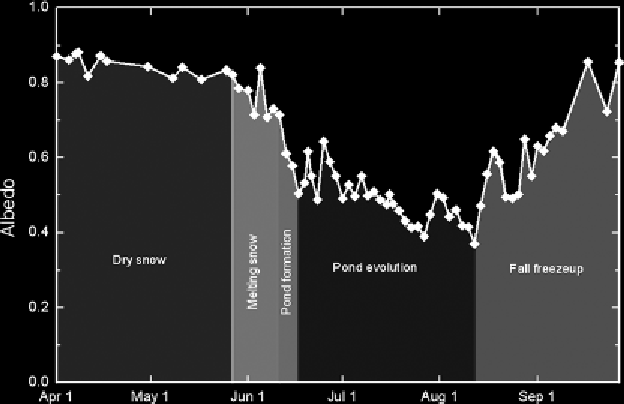Geoscience Reference
In-Depth Information
characteristics of the incident flux is augmented by multiple scattering between the
surface and cloud base (Wiscombe and Warren,
1980
). These processes increase the
proportion of visible band radiation for which scattering is greatest, hence increas-
ing the albedo. Multiple scattering between a stratiform overcast sky and a snow
surface can cause a 7-20 percent increase in snow albedo compared to clear skies
(Petzold,
1977
; Choudhury and Chang,
1981
). The effect of increasing the diffuse
component is to change the effective solar zenith angle (Warren,
1982
). The effec-
tive solar zenith angle for overcast conditions is about 50°. Hence, if the true solar
zenith angle is greater than 50°, the effect of clouds is to decrease the effective solar
zenith angle and reduce the albedo. By contrast, if the true solar zenith angle is
less than 50°, the effect of clouds is to increase the effective solar zenith angle and
increase the albedo. According to Warren (
1982
) the effect of the spectral shift in
the incident flux (enrichment of the visible-band portion) is normally greater than
the effect of the changed zenith angle, such that cloud cover increases the albedo.
The snow albedo can also be influenced by the surface morphology. J. Carroll and
B. Fitch (
1981
) found a reduction in albedo of 4 percent during periods when the
solar zenith angle is normal to sastrugi in the surface snow cover (resulting in shad-
owing) compared to periods when it is parallel to sastrugi.
5.4.4
A Typical Seasonal Cycle over Sea Ice
As part of the SHEBA experiment in 1997-1998 in the Beaufort Sea, detailed
measurements were made of the surface albedo. The seasonal cycle shown in
Figure 5.3
can be taken as very typical of the sequence of events over the perennially
Figure 5.3.
Seasonal cycle of surface albedo as measured based on data collected
during the SHEBA experiment (courtesy of Donald Perovich, USA CRREL). (See plate
section for color version.)

